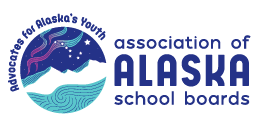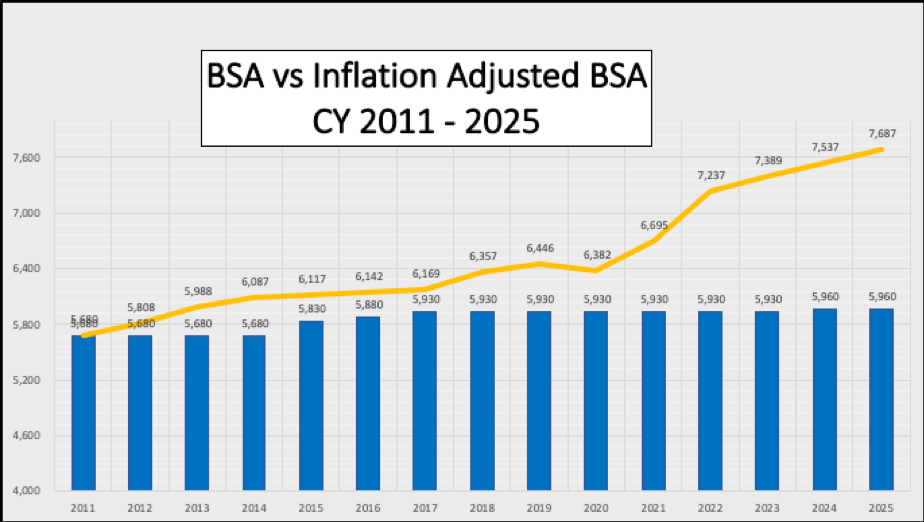The Case for Increasing Funding for Public Education
Alaska must invest today so that we have the workforce we need tomorrow.
Alaska does not have the workforce it needs.
- Alaska’s working-age labor force has declined by 5.4% over the past decade. 1
- In a recent survey of employers & stakeholders, 100% agreed that challenges facing employers’ ability to fill their talent needs are difficult or severe. 2
- More people are leaving Alaska than are moving to the state. 3
- Poor school quality can prevent families from choosing Alaska. According to the Chief of Staff for the Airforce, school quality is the number one quality of life factor for military families. 4
Alaska’s investment in education has steadily declined while the cost of running schools has gone up.
- From 2012 to 2022, the BSA increased by $280 per student, a rate of 4.9%. The inflation rate for that same period was six times higher at 30% (Anchorage CPI). 5 This data depicts a $1,413 difference between the current BSA and an inflation-adjusted BSA.
- In the 1980s and ‘90s, Alaska had a distinct competitive advantage; it had the highest average salary for teachers at 170% above the national average. In 2022, Alaska ranked 10th in the nation, just 111% above the average. Meanwhile, neighboring states have significantly increased their pay. 6
- In per-student spending, Alaska now spends less than the national average when adjusted for the cost of living. 7
A decade of cuts to our education system has left the next generation unprepared.
- Alaska has the highest youth disconnection rate in the nation; one out of every five young adults aged 16 to 24 are not connected with school or work. 8
- Alaska’s postsecondary enrollment rates are almost half of what they were a decade ago; we now have the worst postsecondary outcomes in the nation. 9
- Programs and positions like career guides that helped double the rate of Alaskan students enrolling and completing degree programs in rural communities have been cut. 10
- Schools are not able to offer the breadth, variety, and quality of courses they were a decade ago. 11
Education quality has and will continue to decline as Alaska fails to recruit and retain teachers.
- Alaska currently ranks 49th in education according to the US News and World Report’s ranking. 12
- Teachers, principals, and superintendents are leaving the profession or the state altogether due to lower salaries, holding more than one position, and teaching at more than one school site. 13 High teacher and principal turnover rates are closely linked to decreased student achievement. 14
Sources
- Sandberg, Eric. “The Working Age Population Decline.” Alaska Economic Trends. Alaska Department of Labor & Workforce Development. Mar. 2023 https://labor.alaska.gov/trends/mar23.pdf ↩︎
- Alaska Workforce Development Board, Workforce Development Summit Pre-Survey, shared 30 Oct. 2023 ↩︎
- Sandberg, Eric. “Migration by age since 1985.” Alaska Economic Trends, Alaska Department of Labor. Mar. 2021. https://labor.alaska.gov/trends/mar21.pdf ↩︎
- Burnette, Daarel. “School Quality a Critical Family Issue for Military.” Education Week, 24 Sept. 2019. https://www.edweek.org/policy-politics/school-quality-a-critical-family-issue-for-military/2019/09 ↩︎
- AASB internal analysis using data from the US Bureau of Labor Statistics for the Anchorage CPI and the history of annual BSA funding from the DEED website. Lon Garrison, Executive Director, AASB. ↩︎
- Brooks, James. “Alaska governor’s staff blocked publication of state agency’s analysis of teacher pay.” Anchorage Daily News, 27 Oct. 2023. https://www.adn.com/politics/2023/10/26/alaska-governors-staff-blocked-publication-of-state-agencys-analysis-of-teacher-pay/ ↩︎
- DeFao, Dayna. “Alaska spending on K-12 falls below the national average.” UAA Center for Economic and Social Research, Center for Education Policy Research, University of Alaska Anchorage. 31 Mar. 2023. ↩︎
- “Youth Disconnection in America.” Measure of America, Social Science Research Council. Accessed 6 Nov. 2023. https://measureofamerica.org/DYinteractive/#State ↩︎
- Alaska’s Higher Education Almanac 2023. Alaska Commission on Postsecondary Education, 2 June 2023. https://acpe.alaska.gov/Portals/3/OTHER/Pubs/2023_Almanac_E-Version.pdf ↩︎
- Alaska College and Career Guidance; Interview Findings & Resources. McKinley Research Group for AASB, Aug. 2023. https://aasb.org/wp-content/uploads/Alaska-College-and-Career-Guidance-Report-Aug2023.pdf ↩︎
- Galvin, Alyse. “By Neglecting Education, Alaska is Failing its Children.” Anchorage Daily News, 31 Oct. 2023. https://www.adn.com/opinions/2023/10/31/opinion-by-neglecting-education-alaska-is-failing-its-children/ ↩︎
- “Best States 2023.” U.S. News and World Reports. Accessed 7 Nov. 2023. https://www.usnews.com/news/best-states/rankings/education ↩︎
- Vazquez Cano, M., Bel Hadj Amor, H., & Pierson, A. (2019). Educator retention and turnover under the midnight sun: Examining trends and relationships in teacher, principal, and superintendent movement in Alaska. Portland, OR: Education Northwest, Regional Educational Laboratory Northwest. https://files.eric.ed.gov/fulltext/ED598351.pdf ↩︎
- DeFeo, Dayna, D. Hirsbherg, A. Hill. “It’s more than just dollars.” https://scholarworks.alaska.edu/bitstream/handle/11122/8323/Defeo%20et%20al.pdf?sequence=4&isAllowed=y ↩︎
34% of high school graduates enrolled in a two- or four-year program within a year of graduating high school in 2022. Alaska’s enrollment rates are more than 10% lower than the next lowest state. At these rates, 1 in 9 high school seniors will earn a bachelor’s degree six years from now.
Alaska College and Career Guidance; Interview Findings & Resources


